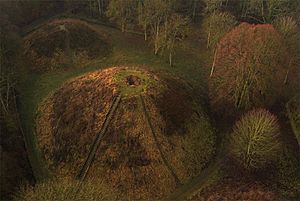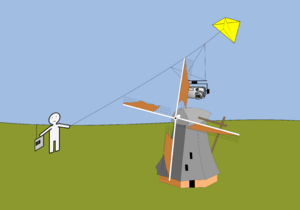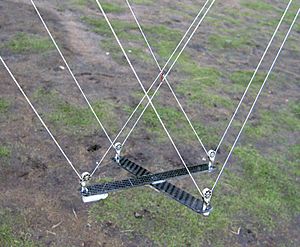Kite aerial photography facts for kids
Kite aerial photography (often called KAP) is a cool way to take pictures from high up in the sky! It works by using a kite to lift a camera into the air. The camera then takes photos from above, giving you a bird's-eye view. You can make the camera take pictures either by controlling it from the ground or by setting it to take photos automatically.
KAP setups can be very simple, like a basic camera with a timer, or quite advanced, using remote controls and digital cameras. Sometimes, KAP is a great choice instead of using other methods for aerial photography, especially if you need to take pictures quietly or in places where drones might not be allowed.
Contents
How Do Camera Rigs Work?
The camera isn't usually tied directly to the kite. Instead, it's often placed on a special frame called a "rig." This rig hangs from the kite line a little distance away from the kite itself. Hanging the rig lower helps stop too much shaking from the kite reaching the camera. It also lets you get the kite flying steadily high up before you attach the camera.
To get clear photos, it's best to set the camera to a very fast shutter speed. This helps prevent blurry pictures if the camera moves. Some cameras also have "image stabilization," which is a feature that helps keep the image steady. For photos to look straight and level with the ground, the rig uses special ways to hang so it automatically stays balanced under the kite line.
Keeping the Camera Level: Pendulum Style
This is a simple way to keep the camera level. The camera hangs from a stiff bar below the kite line. Just like a pendulum on a clock, gravity naturally pulls the camera rig down, keeping it level no matter how the kite line is angled. The rig might swing a bit because of wind or kite movement, but the camera itself will stay much steadier and more level than if it were just tied directly.
Keeping the Camera Level: Picavet Style
The Picavet suspension is named after its French inventor, Pierre Picavet. It uses a stiff cross-shaped frame that hangs below the kite line from two points. A single string is woven back and forth through several small hooks or pulleys on the cross and the kite line. The camera rig is attached to this cross. The way the string is threaded allows the weight of the rig to naturally pull it into a level position. People have changed the size and shape of the Picavet many times to try and make it even more stable or easier to carry.
Taking Pictures and Moving the Camera
The camera's shutter (the part that opens and closes to take a picture) can be triggered in a few ways. It depends on the camera and how fancy the rig's electronics are. Some ways include:
- Using a remote-controlled motor (called a servo) to push the shutter button.
- Sending a special signal (like infrared or a wire connection) to tell the camera to take a picture.
- Using the camera's own built-in timer (called an intervalometer) to take photos at regular times.
It's usually best to wait until the camera has reached its highest point and is flying steadily before you start taking pictures. This avoids blurry photos from the launch.
If the camera is fixed directly to the kite or line, it's hard to change its position. But if the camera is in a rig, the rig can be designed to turn side-to-side and up-and-down. You can even rotate the camera to take pictures in tall (portrait) or wide (landscape) format. You can adjust these angles before launching the kite, or you can use a remote control or an automatic system on the rig to change them while the kite is in the air. Many people use radio control systems, similar to those used for model airplanes, because their motors (servos) are easy to adapt for moving the camera rig. Some automatic controllers can even take a photo, move the camera a little bit, then take the next photo, and so on.
Choosing the Right Kites

The most important thing for a kite used in KAP is that it must be very stable. Usually, people use single-line kites because they can fly with very long lines and don't need as much attention from the person flying them compared to steerable kites.
Almost any stable kite can lift a light camera rig (up to about 500 grams or 1 pound). But as the weight increases, certain kite designs are chosen for their special features, like how much pull they create, what wind speeds they can handle, how high they fly, and how easy they are to launch.
Popular kite designs for KAP include:
- Parafoil: These are very popular because they create a strong pull for their size and can be packed away easily since they don't have stiff poles.
- Rokkaku: A traditional Japanese kite, known for stability.
- Delta: A triangular kite, including variations like the delta conyne.
- Helikite: A newer design that is lighter than air and can help with KAP in tricky weather.
Kites like the rokkaku or delta often fly at a higher angle than parafoils. This is helpful if you don't have much space between where you launch the kite and what you want to photograph. A higher flying angle means the kite can lift more weight because more of its lifting force is going straight up. Helikites are especially good for professional photography because they work well even in difficult conditions.
KAP Today

Kite aerial photography has become much more popular thanks to the internet, affordable digital cameras, remote controls, and tiny electronics. Nowadays, you can even buy kits that help beginners quickly put together a KAP rig and start taking aerial pictures. You can take photos not just in regular light, but also in ultraviolet, near-infrared, and thermal infrared light if you have more experience!
However, using KAP for practical or business purposes has some limits. The weather can be unpredictable (wind, sun, rain), and not every location is good for flying a kite. For example, launching a kite near buildings or downwind of trees can be hard because of strong, swirling winds.
Today, KAP is mainly used for:
- Amateur photography: People taking pictures for fun.
- Art: Artists using unique perspectives.
- Archaeology: It's very useful for studying old sites, as seen on the West Lothian Archaeological Trust website.
- Community mapping and environmental monitoring: Groups like the Public Laboratory for Open Technology and Science use it to map areas and check on the environment.
- Scientific research: Scientists use KAP to study birds, geography, and geology, including making detailed maps (photogrammetry).
More and more, kites are being used instead of small drones when drones are too difficult to use, or when there are legal rules or other problems with flying them. Trying to make KAP a big business has not been very successful so far.
Images for kids
-
Henry Wellcome's automatic kite camera, used in Sudan, 1912–1913.
-
A kite photo by George Lawrence of San Francisco after the earthquake of 1906.
-
An old postcard of Grand Rapids, Michigan, taken with a kite.






